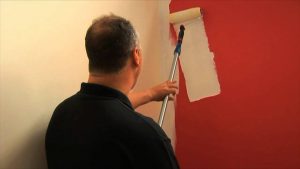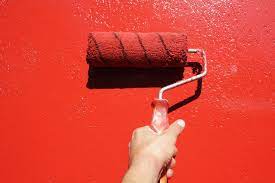Red is a challenging color to paint on walls because it is challenging to get good coverage and because it is challenging to get the ideal shade that you won’t regret. I really enjoy using red paint for accent walls or even entire rooms, like the article’s red dining room, which I painted myself. Without using the Best Color Primer For Red Paint beforehand, painting red on walls—especially over white—can become a nightmare. Red is the ideal eye-catching color choice when painted appropriately because when painted incorrectly, it is incredibly vivid and covers poorly.
Contents
Why do we need Color Primer For Red Paint?
The concept of a base primer for a particular color is certainly foreign to most people. Even to teams of painters and small paint dealers. Many people do not even know the existence of this painting. So what is it and what is its use for?
This base primer is not the same as an alkali-resistant primer. It also cannot replace alkali-resistant primer. Its main function is to provide a background for specific colors that can be accurately colored. Depending on the colors, we have our own base primer formula. Not all colors are created equal. That is also the special point of this painting. It is not a ready-made type, but when we have selected the color, we then mix the base primer to match that color. This paint has extremely high coverage and can stimulate difficult colors, up to color standards.
So what colors need to use in this special paint? Those are the 3 main colors Red, Yellow, and Green. When you go to buy paint, it is better to choose large paint dealers. You will be advised to use a base primer for a particular color. Small dealers may not even know this paint exists. Not even knowing what colors to use. Large dealers will be instructed by the paint company and have their own notice, so about the colors that need special handling they know very well.
If this primer is not used, what will be the consequences?
- Firstly the color should not be standard.
- Secondly, after the paint film dries, darker streaks will appear, especially between the boundary of the 2 plots. For example, let’s say you paint banana green. If you do not use a base primer for a special color, you will not be able to stimulate the yellow light in this color but will turn bluer.
Can we use this paint instead of alkaline primer during the construction process? The answer is no. You must apply an alkaline primer first, then a base primer for a special color. Finally, apply 2 coats of paint. Next, we continue to find The Best Color Primer For Red Paint.
The Best Color Primer For Red Paint
The ideal approach to painting red over white is with the Best Color Primer For Red Paint which is gray-colored, not one that is closely tinted to the color of red. Paint covers much better and is much easier to touch up with a base layer of gray primer. Look check the swatch’s reverse side before choosing your paint color. Most paint manufacturers advise using a tinted primer for strong hues, such as crimson and other deep foundation colors.
For instance, Sherwin Williams employs a proprietary Color Prime System with a numerical grade ranging from “P1,” the lightest shade of gray primer, to “P6,” the darkest shade of gray primer. To obtain the best coverage from your red, pick the gray primer that is suggested for it. The color of the paint won’t change with the appropriate tint of tinted Best Color Primer For Red Paint.
Use latex as a primer. Sherwin Williams’ Multi-Purpose and PrepRite latex primer is a product I’ve used numerous times with great success. Less than three hours pass after the Best Color Primer For Red Paint dries for painting. The retailer will tint the primer the appropriate shade of gray for the red you select.
Is a primer necessary for red paint?
Priming. For preventing red paint from bleeding through your new layers of paint, water-based sealing primers work best. The Best Color Primer For Red Paint should be applied in at least two coats, with sufficient drying time in between.
What would make a decent red foundation color?
Yellow, white, tawny-orange, green, blue, and black all go well with primary red. Together with cyan, mint green, sand, creamy-white, and grey, tomato red looks great. Azure, grey, light orange, sandy, pale yellow, and beige all complement cherry red effectively.
Can I apply red paint over grey primer?
As these grey bases performed better under deep colors than a close match base color, we first advised using a light grey primer coat for deep reds and oranges or a dark grey primer coat for deep blues, greens, and browns.
How to apply the Best Color Primer For Red Paint?
To stop paint drips from leaking through, carefully cover the flooring with heavy-weight drop cloths (10 to 12 ounces). Tile can be cleaned of red paint, but carpeting is a different matter. For painting, mask off the trim with premium masking tape. Using an extension pole, cut in and roll one coat of tinted primer onto the walls. Then, let the primer dry for the advised amount of time. Before priming the walls, ensure that all of the wall mendings have been completed.
Apply the paint in the same manner as you would the Best Color Primer For Red Paint. Make sure the walls are rolled from one side of the wall to the other for the greatest finish. Roll the walls uniformly from top to bottom, maintaining a wet edge. Red typically covers in two coats with the correct colored primer but depending on the hue, a third coat can be necessary. Use a satin finish for the paint to give the red a lovely shiny touch.
What is The Best Red Brush and Roller?
When applying red interior paint, always use a lint-free roller to avoid creating fuzzy walls. Use caution while using a roller with a thick nap. A 1/2-inch roller nap is ideal. The nap is sufficient enough to apply the paint evenly without leaving a noticeable stippling pattern on the walls.
Use only a premium paintbrush to cut in by hand unless you’re securing the corners with painter’s tape. For the majority of my wall painting work, I use Purdy White Dove paint rollers with a 1/2-inch nap. For painting red and other colors, these are lint-free and ideal. I’ve always liked Purdy brushes, especially the Purdy Clearcut brush in the 3-inch size.








